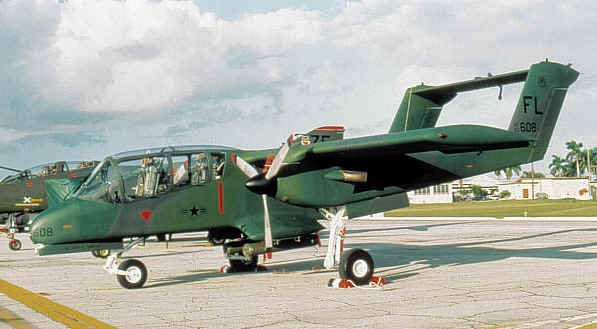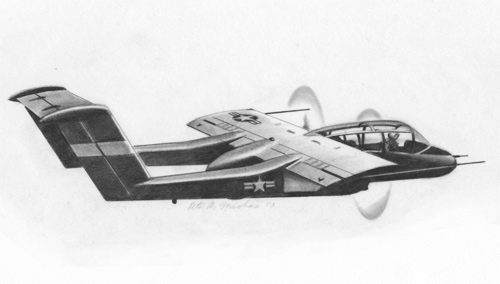|

(Photo by Jake Donovan, Capt, USN Ret.,
at Key West NAS, 1988.)
History: In the early
1960s, the United States Marine Corps needed an airplane for primarily reconnaissance
missions with light armament capabilities as well. In response to the USMC’s
requests, the unique OV-10 Bronco design submitted by the North American (Rockwell)
company proved to be as adaptable as the changing times. Seven prototypes were produced in
1964, and on the 16th of July 1965, the first OV-10 took wing. Praised for its
high-visibility cockpit and rear cargo compartment, the Bronco was immediately recognized
as an all-purpose workhorse. The first production OV-10s were powered by husky Garrett
T76-G-416/417 turboprop engines and served the Marines and United States Air Force well.
157 OV-10As saw action in Vietnam in 1968 in service with the
USAF.
Although originally outfitted with machine-gun
turrets for service in Vietnam, the Bronco’s chameleon-like ability to fulfill all
kinds of missions became quite evident in its subsequent variations. The most notable
version was the OV-10D NOS (Night Observation Surveillance),
with more advanced sensor equipment in its nose consisting of infrared equipment, laser
targeting capabilities, and other modifications including 20-mm cannon upgrades and beefier powerplants. 17 Broncos saw this conversion take place in 1979-1980, and it became the
more favored variant rather than the more complicated YOV-10D NOGS
(Night Observation/Gunship System). Only two NOGS supplied the USMC with advanced night
operations. In 1991, USMC OV-10D NOS birds participated in Operation Desert Storm
primarily for night surveillance. OV-10B variants have served
Germany as target tugs, and OV-10F, OV-10C,
OV-10E aircraft have been supplied to Indonesia, Thailand, and
Venezuela, respectively.
The OV-10 Bronco has been officially retired in the
United States since 1994, but some remain in service in the above-mentioned countries as
well as Morocco and the Philippines. Domestically, OV-10s work with federal and state
agencies as fire spotters. The Bronco is most active in Thailand, where it is involved in
FAC and COIN operations near the disputed borders of neighbors Laos and Kampuchea. No
matter where it is needed or what it is used for, the versatile, unique-looking OV-10
Bronco will always serve its pilots well.
Nicknames:
"Bronc"
Specifications (OV-10D):
Engines: Two 1,040-shp Garret T76-G-420/421 turboprops
Weight: Empty 6,893 lbs., Max
Takeoff 14,444 lbs.
Wing Span: 40ft. 0in.
Length: 44ft. 0in.
Height: 15ft. 2in.
Performance:
Maximum Speed at
Sea Level: 288 mph
Ceiling: 30,000
ft.
Range: 430 miles
in full combat configuration.
Armament: Up to 3,600 pounds of assorted
bombs, cannon, machine guns and missiles on five weapon attachment points; plus 1,200
pounds of bombs on two underwing pylons. Wing pylons can also carry missiles or external
fuel tanks.
Number Built: Approximately
300
Number Still Airworthy: One
is operated as a warbird in France, and at least three fly in private hands in the USA.
At least 10 are operated as government-owned fire spotters in the USA.
Links:
Aviation Collectibles of
Texas' OV-10 Products
Aviation
Enthusiasts Corner -- OV-10 Page
Boeing's OV-10 Page
Earle Aircraft, Inc.,
Hastings, Florida, USA. -- OV-10 restoration projects
"Eye
of the Storm" -- Desert Storm Bronco-shootdown story.
Federation of Amercian
Scientists (FAS) OV-10 page
Jirka
Wagner's OV-10 Page
OV-10 Bronco.net -- The
authoritative source of OV-10 information.
USAF Museum --
OV-10
Virtual Aviation Museum
-- OV-10 Page

OV-10 Bronco
by Peter Michas

[Back to Warbird Alley's Main
Page]
All text and photos Copyright 2016 The
Doublestar Group, unless otherwise noted.
You may use this page for your own, non-commercial reference purposes only.
 |